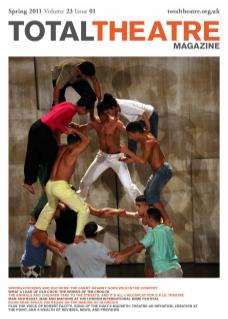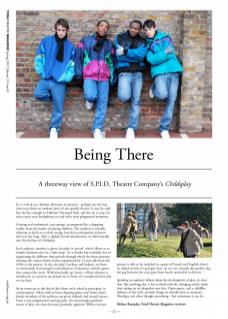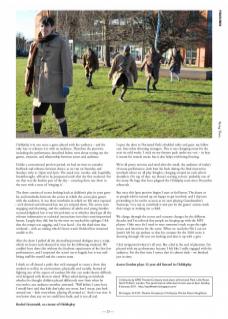It’s 3 o’clock on a Sunday afternoon in January – perhaps not the best time to perform an outdoor piece of site-specific theatre. It may be cold, but the sky is bright in Fulham’s Normand Park, and the air is crisp. It’s time to put your headphones on and relive your playground memories.
A young and enthusiastic cast emerge, accompanied by a shopping trolley, from the hordes of playing children. The audience is initially reluctant to latch on to their energy, but their participatory reticence does not last long. After a slightly forced introduction, we fall naturally into the rhythm of Childsplay.
Each audience member is given a headset or ‘portal’, which allows us to transfer between eras via a ‘time warp’. It’s a clunky but workable way of negotiating the different time periods through which the show journeys, charting the various forms of play experienced by 12-year-olds from the 1950s to the present. As the cast play Cowboys and Indians, we listen to testimonials from people’s remembrances of playtime, and the games they enjoyed the most. With historically apt music, a filmic element is introduced, as scenarios are played out in front of a soundtrack that only we can hear.
As we warm up to the idea of this show, we’re asked to participate in various games. Taken aside to learn clapping games and ‘Jenny Jones’, female members of the audience are given rhubarb and custard sweets. From a non-judgemental starting point, the increasingly gendered nature of play over time becomes gradually apparent. While everyone present is able to be included in a game of French and English, there’s an added severity if a girl gets hurt. As we veer towards the modern day, the gap between the sexes goes from barely noticeable to divisive.
Sparking an audience debate about the development of play, it’s clear that, like anything else, it has evolved with the changing world, rather than taking on an altogether new face. Open spaces, and a childlike defiance of the cold, are both things we should strive to maintain. Nostalgia isn’t often thought-provoking – but sometimes it can be.
Helena Rampley, Total Theatre Magazine reviewer
Childsplay is in one sense a game played with the audience – and the only way to rehearse it is with an audience. Therefore the previews, including the performance described below, were about testing out the games, structure, and relationship between actors and audience.
Unlike a conventional preview period, we had no time to consider feedback and rehearse between shows, as we run on Saturday and Sundays only, at 12pm and 3pm. The usual cuts, tweaks, and, hopefully, breakthroughs, all had to be postponed until after the first weekend. For me that was the hardest part of the day – careering from one show to the next with a sense of ‘winging it’.
The show consists of scenes looking back at children’s play in years gone by, and interludes between the scenes in which the actors play games with the audience. It was these interludes in which we felt most exposed – we’d devised and rehearsed but not yet scripted them. The actors were engaging and charming, and the audience of adults and young families seemed delighted, but it was hit-and-miss as to whether they’d get all the relevant information or technical instructions into their semi-improvised banter. Largely they did, but by the time we reached the epilogue I felt that the tempo was sagging, and I was faced – for the third time that weekend – with an ending which I knew wasn’t finished but remained unable to fix.
After the show I pulled all the devised/improvised dialogue into a script, which we learnt and rehearsed in time for the following weekend. We couldn’t have done this without the freeform experiments of the first few performances, and I respected the actors’ nerve hugely, but it was nail-biting stuff for myself and the creative team.
I think we all shared a pride that we’d managed to create a show that worked so well in its environment, physically and socially. Instead of fighting any of the aspects of outdoor life that can make theatre difficult, we’d designed with them in mind. When asked during an interlude whether he thought children played differently now from when he was twelve, one audience member answered, ‘Well before I came here I would have said that kids don’t play any more, but I mean, just look around you – kids everywhere, playing all around us.’ And it was true. It was better than any set we could have built, and it was all real.
Rachel Grunwald, co-creator of Childsplay
I open the door to Normand Park’s disabled toilet and greet my fellow cast, four other shivering teenagers. This is our changing room for the next six cold weeks. I stick on my thermo pack under my vest – its heat is meant for muscle strain, but it also helps with being freezing.
We’re all pretty nervous and tired after the small, shy audience of today’s 12-noon performance. Josh hurt his back during the final interactive interlude where we all play Knights, charging around on each other’s shoulders. On top of that, my throat’s starting to hurt, probably one of the many flu bugs that have plagued the Childsplay team since December rehearsals.
But once this 3pm preview begins I start to feel better. The dozen or so people who’ve turned up are happy to get involved, and I slip into pretending to be twelve as soon as we start playing Grandmother’s Footsteps. I try not to overthink it and just let the games’ actions work their magic at making me a child.
We charge through the scenes and costume changes for the different decades and I’m relieved that people are keeping up with the MP3 players. Only once do I need to reset someone’s track to get the right music and interviews for the scene. When we reach the 90s I can see Jamie’s left his zip undone so that his costume for the 2010 scene is showing through. He sees me looking and does it up with a grin.
I feel invigorated when it’s all over, like a kid at the end of playtime. I’m pleased with my performance because I felt like I really engaged with the audience. For the first time I notice that it’s almost dark – we finished just in time.
Aaron Gordon plays 12-year-old Samuel in Childsplay
Childsplay by SPID Theatre Company took place at Normand Park, Lillie Road, North Fulham, London. The performance reflected on here was at 3pm, Sunday 9 January 2011. http://spidtheatre.blogspot.com/ All images: S.P.I.D. Theatre Company’s Childsplay. Photos Alison Neighbour


